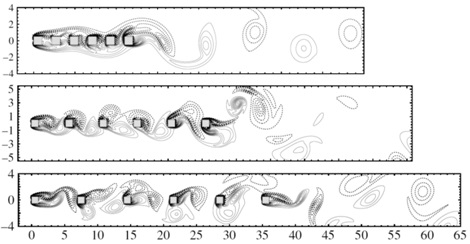
The flow downstream of multiple bodies placed in the flow has many practical engineering applications. A row of bodies is often used to screen strong and sudden winds in order to change them to weak and gentle ones. Cascades of bodies, with a narrow spacing between them, are often used in wind tunnels to obtain a uniform velocity distribution. The flow past a row of bodies is of interest in situations such as turning vanes in duct elbows, multi-slotted airfoils, and flow around closely spaced electrical power poles. Similarly, birds have been observed to fly in V-formation but the reason for this behaviour is not understood.

The flow around multiple bodies is a spatially developing flow problem, where several rich phenomena are observed (see figure). Change in the flow behaviour has implications on the instantaneous and mean forces experienced by the bodies. In our work, we have numerically and experimentally studied flow around multiple bodies arranged in different configurations. We proposed that certain flow regimes will always be present, irrespective of how the bodies are placed. This hypothesis was proved for bodies placed row-wise, column-wise, in V-shape, and when transversely oscillated. This is particularly important because no such previous attempt was made prior to his work.
Burattini, P., and Agrawal, A.,
"Wake interaction between two side-by-side cylinders in channel flow," Computers & Fluids, Vol. 77, pp. 134-142, 2013.
Sewatkar, C.M., Patel, R., Sharma, A. and Agrawal, A.,
"Flow around six in-line square cylinders," Journal of Fluid Mechanics, Vol. 710, pp. 195-233, 2012. (cover page article)
Sewatkar, C.M., Sharma, A., and Agrawal, A.,
"On energy transfer in flow around a row of transversely oscillating square cylinders at low Reynolds number," Journal of Fluids and Structures, Vol. 31, pp. 1-17, 2012.
Prasad, K., Paramane, S.B., Agrawal, A., and Sharma, A.,
"Effect of channel-confinement and rotation on the two-dimensional laminar flow and heat transfer across a cylinder," Numerical Heat Transfer A, Vol. 60 (8), pp. 699-726, 2011.
Sewatkar, C.M., Sharma, A., and Agrawal, A.,
"Simulation of flow across a row of transversely oscillating square cylinders," Journal of Fluid Mechanics, Vol. 680, pp. 361-397, 2011.
Sewatkar, C.M., Sharma, A., and Agrawal, A.,
"A first attempt to numerically compute forces on birds in V-formation," Artificial Life, Vol. 16 (3), pp. 245-258, 2010.
Sewatkar, C.M., Sharma, A., and Agrawal, A.,
"On the effect of Reynolds number for flow around a row of square cylinders," Physics of Fluids, Vol. 21 (083602), pp. 1-13, 2009.
Kumar, S.R., Sharma, A., and Agrawal, A.,
"Simulation of flow around a row of square cylinders," Journal of Fluid Mechanics, Vol. 606, pp. 369-392, 2008.
Agrawal, A., Djenidi, L., and Antonia, R.A.,
"Investigation of flow around a pair of side-by-side square cylinders using the lattice Boltzmann method," Computers & Fluids, Vol. 35, pp. 1093-1107, 2006.
Hrisheekesh, K., Agrawal, A., Sharma, A., Shridan, J.,
"Near Body Vorticity Dynamics of a Square Cylinder Subjected to Inline Excitation Superimposed over Mean Flow," Physics of Fluids, Vol. 28, 093605 (24 pp), 2016.
References